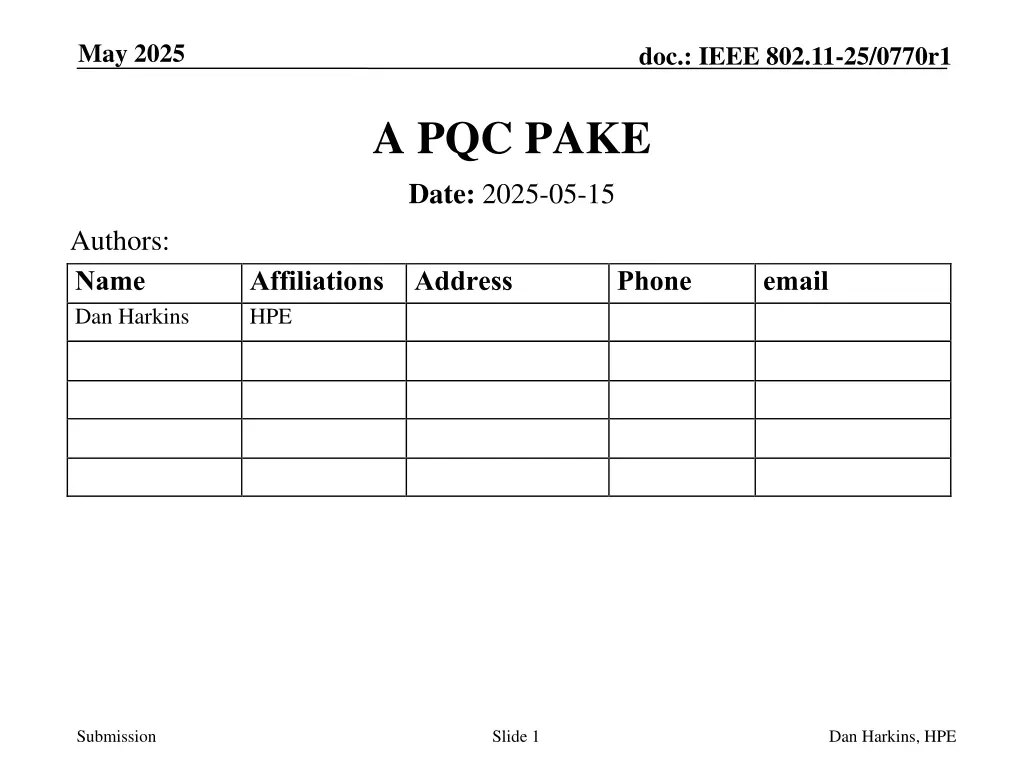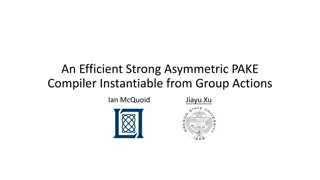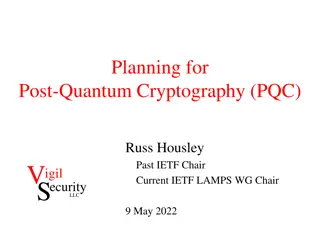
Post-Quantum Cryptography in IEEE 802.11-25/0770r1 Document
This submission delves into ongoing work within the CFRG of the IRTF concerning the potential implementation of post-quantum cryptography in the upcoming PQ TG in 802.11 standards. It addresses the challenges of adapting existing key exchange protocols, such as SAE, to be post-quantum resistant and proposes a new protocol using ML-KEM for this purpose.
Uploaded on | 4 Views
Download Presentation

Please find below an Image/Link to download the presentation.
The content on the website is provided AS IS for your information and personal use only. It may not be sold, licensed, or shared on other websites without obtaining consent from the author. If you encounter any issues during the download, it is possible that the publisher has removed the file from their server.
You are allowed to download the files provided on this website for personal or commercial use, subject to the condition that they are used lawfully. All files are the property of their respective owners.
The content on the website is provided AS IS for your information and personal use only. It may not be sold, licensed, or shared on other websites without obtaining consent from the author.
E N D
Presentation Transcript
May 2025 doc.: IEEE 802.11-25/0770r1 A PQC PAKE Date: 2025-05-15 Authors: Name Dan Harkins Affiliations Address HPE Phone email Submission Slide 1 Dan Harkins, HPE
May 2025 doc.: IEEE 802.11-25/0770r1 Abstract This submission discusses some work being done in the CFRG of the IRTF and it s potential for use in the upcoming PQ TG in 802.11 Submission Slide 2 Dan Harkins, HPE
May 2025 doc.: IEEE 802.11-25/0770r1 What s The Problem? It s straightforward to drop ML-KEM into a standard Diffie-Hellman key exchange but SAE uses the dragonfly key exchange as its PAKE dragonfly is not a simple Diffie-Hellman exchange It is not possible to just drop ML-KEM into the exchange and make it PQ-resistant Need to come up with a new protocol which implements a PAKE using post-quantum cryptography Submission Slide 3 Dan Harkins, HPE
May 2025 doc.: IEEE 802.11-25/0770r1 The Original PAKE Encrypted Key Exchange (EKE) by Bellovin and Merritt The peers did a Diffie-Hellman and encrypted the exponentials sent to each other using (a key derived from) the password Susceptible to attack if the exponential has structure prior to encryption What you encrypt and how you encrypt it impacts your provable security OEKE is a variant Only 1 side encrypts, the other sends an authenticating tag Authenticates one peer Some EKE variants rely on the Ideal Cipher model for security proof An Ideal Cipher exists in theory, practice is a little different Submission Slide 4 Dan Harkins, HPE
May 2025 doc.: IEEE 802.11-25/0770r1 NoIC No Ideal Cipher An OEKE-like PQC PAKE that uses ML-KEM Provably secure! (see document in references) Uses 2 round Feistel network (2F) instead of a keyed cipher left wire is random coins, right wire is the plaintext r M R H1(K,*) t H2(K,*) s T Submission Slide 5 Dan Harkins, HPE
May 2025 doc.: IEEE 802.11-25/0770r1 NoIC* Bob= (sid, Bob, Alice, pwd, resp) Alice= (sid, Alice, Bob, pwd, init) fsid (sid, Alice, Bob) (sk, pk) KEM.KeyGen() r random fsid (sid, Alice, Bob) s, T (s, T) = 2F(pwd, r, pk) ((r, pk) = 2F-1(pwd, s, T) (c, K) KEM.Encaps(pk) tag Htag(fsid, pwd, pk, s, T, c, K) c, tag K KEM.Decaps(sk, c) if (tag != Htag(fsid, pwd, pk, s, T, c, K)) key = random else key = Hkey(fsid, pwd, pk, s, T, c, K) return key key = Hkey(fsid, pwd, pk, s, T, c, K) return key * 2F is simplified for brevity. See Figure 4 in the NoIC paper in references for the unsimplified view Submission Slide 6 Dan Harkins, HPE
May 2025 doc.: IEEE 802.11-25/0770r1 NoIC Simple 2 message exchange Does implicit rejection (same as ML-KEM!) Need to do key confirmation Security proof assumes uniform public keys But the ML-KEM pk has too much structure Need to randomize pk before passing to 2F draft-veitch-kemeleon-00 Defines several encodings to randomize ML-KEM public keys and ciphertexts One such encoding is non-rejecting - i.e. no looping needed! Submission Slide 7 Dan Harkins, HPE
May 2025 doc.: IEEE 802.11-25/0770r1 Non-Rejecting Kemeleon ML-KEM encaps key is a vector of polynomials, each with 256 coefficients, plus a 32 byte random number Coefficients are 12bits each and it is necessary to deserialize and serialize before encoding and after decoding, respectively Given q=3329, n=256, k from the ML-KEM parameter set, and t as a fixed security parameter: VectorEncodeNR(a): r = 0 t = sec_param # e.g. t = 128, 256, ... b = log2(q(k*n)) for i from 1 to k*n: r += q(i-1) * a[i] m $ [0,...,floor((2(b+t) -r)/q(k*n))] return r + m*q(k*n) VectorDecodeNR(r): r = r % q(k*n) for i from 1 to k*n: a[i] = r % q r = r // q return a Submission Slide 8 Dan Harkins, HPE
May 2025 doc.: IEEE 802.11-25/0770r1 Putting It All Together NoIC plus Kemeleon: draft-vos-cfrg-pqpake-00 A hybrid PAKE called CPaceOQUAKE+ which does CPace using classical cryptography and OQUAKE using ML-KEM and Kemeleon Result of two exchanges are combined to have single key output Includes a registration phase (with server holding salted password) and a key confirmation phase Do we need/want hybrid constructs in 802.11? If so, we can use it directly, possibly without the key confirmation If not, we could just use OQUAKE: NoIC + Kemeleon and do key confirmation ourselves If the PAKE produces a PMK (it does) and a transcript (it does) we could use it with a unified PTK key confirmation/derivation scheme described in 11-25/0631r0! Submission Slide 9 Dan Harkins, HPE
May 2025 doc.: IEEE 802.11-25/0770r1 NoIC* + Kemeleon Alice (sid, A, B, pwd, init) Bob (sid, B, A, pwd, resp) fsid (sid, A, B) (sk, pk) KEM.KeyGen() r random Z = encode_pk(pk) (s, T) = 2F(pwd, r, Z) fsid (sid, A, B) s, T ((r, Z) = 2F-1(pwd, s, T) pk = decode_pk(Z) (c, K) KEM.Encaps(pk) tag Htag(fsid, pwd, pk, s, T, c, K) c, tag K KEM.Decaps(sk, c) if (tag != Htag(fsid, pwd, pk, s, T, c, K)) key = random else key = Hkey(fsid, pwd, pk, s, T, c, K) return key key = Hkey(fsid, pwd, pk, s, T, c, K) return key * 2F is simplified for brevity. See Figure 4 in the NoIC paper in references for the unsimplified view Submission Slide 10 Dan Harkins, HPE
May 2025 doc.: IEEE 802.11-25/0770r1 What it Could Look Like AP advertises a hash of it s ML-KEM encapsulation key STA uses the static encaps key to send a ciphertext and its encrypted identity to the AP AP responds with encrypted sid used for OQUAKE STA and AP engage in OQUAKE Hashed transcript includes not just the OQUAKE messages but the encrypted identity and sid as well Then association and PTK generation using PMK and transcript STA AP PAKE post-auth handshaking Submission Slide 11 Dan Harkins, HPE
May 2025 doc.: IEEE 802.11-25/0770r1 Summary Elegant request-response PQC PAKE encryption only applied by one party Simple randomization algorithm Provable security Requires key confirmation step Submission Slide 12 Dan Harkins, HPE
May 2025 doc.: IEEE 802.11-25/0770r1 References EKE- https://www.cs.columbia.edu/~smb/papers/neke.pdf FIPS 203-- https://nvlpubs.nist.gov/nistpubs/FIPS/NIST.FIPS.203.ipd.pdf NoIC https://eprint.iacr.org/2025/231.pdf Kemeleon https://www.ietf.org/archive/id/draft-veitch-kemeleon-00.html CPaceOQUAKE+-- https://datatracker.ietf.org/doc/html/draft-vos-cfrg-pqpake-00 Submission Slide 13 Dan Harkins, HPE
May 2025 doc.: IEEE 802.11-25/0770r1 Dzi kuj ! Submission Slide 14 Dan Harkins, HPE
May 2025 doc.: IEEE 802.11-25/0770r1 Questions? Submission Slide 15 Dan Harkins, HPE






















